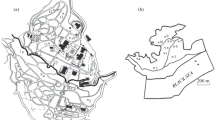Abstract
The structure, dominant groups, and the features of invertebrates’ spacetime distribution have been defined as a result of soil and zoological studies in the cheegrass (Achnatherum splendens (Trin.) Nevski) steppe on solonetzic soils in Transbaikalia. Poor taxonomic diversity and small number and biomass of invertebrates are the peculiarities of the zoological complex. Factors that limit the activity of invertebrates are detected: poor botanical composition, adverse conditions of heat and moisture exchange in the soil, and its physical and chemical properties and salinity. A study of the spatial distribution of invertebrates show that Achnatherum is the basic edificator of the community. In Transbaikalia, two main types of invertebrate communities are formed depending on the seasonal amount of precipitation: desert-steppe and meadow-steppe. The diversity and abundance of invertebrates caught in soil traps positively correlated with precipitation and negatively with temperature. The size of the cheegrass root system has the greatest impact on the distribution of invertebrates in the soil.
Similar content being viewed by others
References
Agroklimaticheskii spravochnik po Buryatskoi ASSR (Agroclimatic Handbook of Buryat ASSR), Leningrad, 1960.
Bazilevich, N.I. and Rodin, L.E., Types of biological circulation of ash elements and nitrogen in the main zones of the Northern Hemisphere, in VIII Mezhd. kongr. pochvovedov “Genezis, klassifikatsiya i kartografiya pochv SSSR,” doklady (The VIII Int. Congr. of Soil Scientists “Genesis, Classification, and Map** of Soils of the Soviet Union,” Reports), Moscow: Nauka, 1964, pp. 134–146.
Bessolitsyna, E.P., Landshaftno-ekologicheskii analiz struktury zootsenozov pochv yuga Sibiri (Landscape-Ecological Structure Analysis of Soil Zoocenosises of the South Siberia), Irkutsk: Inst. Geogr., Sib. Otd., Ross. Akad. Nauk, 2001.
Braak ter, C.J.F., and Verdonschot, P.F.M., Canonical correspondence analysis and related multivariate methods in aquatic ecology, Aquat. Sci., 1995, vol. 57, no. 3, pp. 255–289.
Bragina, T.M., The pattern of changes in soil fauna at desertification by example of dry zone of the Central Asia, Extended Abstract of Doctoral (Biol.) Dissertation, Moscow: Mosk. Gos. Univ., 2004.
Buryatiya: rastitel’nyi mir (Flora of Buryatia), Ulan-Ude: Buryat. Gos. Univ., 1997.
Dambiev, E.Ts., Namzalov, B.B., and Kholboeva, S.A., Landshaftnaya ekologiya stepei Buryatii (Landscape Ecology of Buryat Steppes), Ulan-Ude: Buryat. Gos. Univ., 2006.
Geladi, P., Analysis of multiway (multimode) data, Chemom. Intell. Lab. Syst., 1989, vol. 7, pp. 11–30.
Gilyarov, M.S., Zoologicheskii metod diagnostiki pochv (Zoological Analysis of Soils), Moscow: Nauka, 1965.
Khobrakova, L.Ts., Lavrentieva, I.N., and Danilov, S.N., Invertebrates of the cheegrass steppe on solonchaks of the Western Transbaikalia, in VIII Mezhreg. soveshch. entomologov Sibiri i Dal’nego Vostoka, Novosibirsk, 4–7 oktyabrya 2010 (VIII Interregional Meeting of Entomologists of Siberia and Far East, Novosibirsk, October 4–7, 2010), pp. 209–210.
Klassifikatsiya i diagnostika pochv Rossii (Classification and Analysis of Soils in Russia), Dobrovol’skii, G.V., Ed., Smolensk: Oikumena, 2004.
Korolyuk, T.V., Chemical content and the level of soil salinity in the Ivolga River valley, Buryat ASSR, Pochvovedenie, 1971, no. 7, pp. 92–100.
Malyshev, L.I. and Peshkova, G.A., Osobennosti i genezis flory Sibiri (Predbaikal’e i Zabaikal’e) (Peculiarities and Genesis of Siberian Flora: Cis- and Transbaikalia), Novosibirsk: Nauka, 1984.
Mitupov, Ch.Ts., Saline soils of the Ivolginskaya valley, Extended Abstract of Cand. Sci. (Biol.) Dissertation, Moscow: Mosk. Gos. Univ., 1973.
Mordkovich, V.G., Stepnye ekosistemy (Steppe Ecosystems), Novosibirsk: Nauka, 1982.
Namzalov, B.B., Stepi Yuzhnoi Sibiri (Steppes of Southern Siberia), Ulan-Ude: Buryat. Nauchn. Tsentr, Sib. Otd., Ross. Akad. Nauk, 1994.
Polevoi opredelitel’ pochv Rossii (Field Guide to Identification of Soils in Russia), Moscow: Pochv. Inst. im. V.V. Dokuchaeva, 2008.
Preobrazhenskii, V.S., Fadeeva, N.V., Mukhina, L.I., and Tomilov, G.M., Tipy mestnosti i prirodnoe raionirovanie Buryatskoi ASSR (Types of Territory and Natural Zoning of Buryat ASSR), Moscow: Nauka, 1959.
Reshchikov, M.A., Kratkii ocherk rastitel’nosti Buryat-Mongol’skoi ASSR (Brief Description of Buryat-Mongolian ASSR), Ulan-Ude: Buryat. Knizhn. Izd., 1958.
Shalyt, M.S., Analysis method of morphology and ecology of underground part of single plants and herbal communities, in Polevaya geobotanika (Field Geobotany), Moscow: Nauka, 1960, vol. 2, pp. 369–447.
Striganova, B.R., Transect approach to the assessment of the spatial diversity of soil macrofauna, Biol. Int., 1996, no. 33, pp. 17–33.
Ubugunov, L.L., Lavrentieva, I.N., Ubugunova, V.I., and Merkusheva, M.G., Raznoobrazie pochv Ivolginskoi kotloviny: ekologo-agrokhimicheskie aspekty (Diversity of Soils in the Ivolginskaya Depression: Ecological and Agrochemical Aspects), Ulan-Ude: Buryat. S-kh. Akad., 2000.
Ulykpan, K., The main features soil entomological fauna of dry steppe zone of the People’s Republic of Mongolia, in Nasekomye Mongolii (Insects of Mongolia), Leningrad: Nauka, 1977, no. 5, pp. 17–29.
Ulykpan, K., Soil mesofauna of desert and dry steppes of the People’s Republic of Mongolia, Extended Abstract of Cand. Sci. (Biol.) Dissertation, Ulan Bator, 1978.
Vorob’eva, L.A., Khimicheskii analiz pochv (Chemical Analysis of Soils), Moscow: Mosk. Gos. Univ., 1998.
Author information
Authors and Affiliations
Corresponding author
Additional information
Original Russian Text © L.T. Khobrakova, I.N. Lavrentieva, S.N. Danilov, L.L. Ubugunov, V.I. Ubugunova, S.V. Zaitseva, 2015, published in Sibirskii Ekologicheskii Zhurnal, 2015, No. 1, pp. 89–101.
Rights and permissions
About this article
Cite this article
Khobrakova, L.T., Lavrentieva, I.N., Danilov, S.N. et al. Invertebrates of the cheegrass steppe in solonetzic soils of Transbaikalia: Spatial and time structure. Contemp. Probl. Ecol. 8, 72–82 (2015). https://doi.org/10.1134/S1995425515010072
Received:
Accepted:
Published:
Issue Date:
DOI: https://doi.org/10.1134/S1995425515010072




